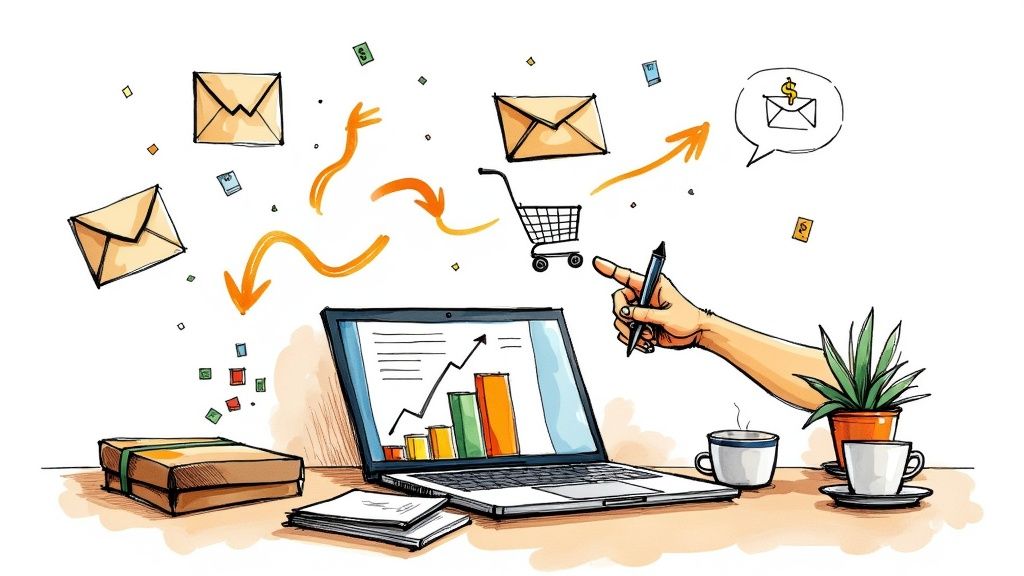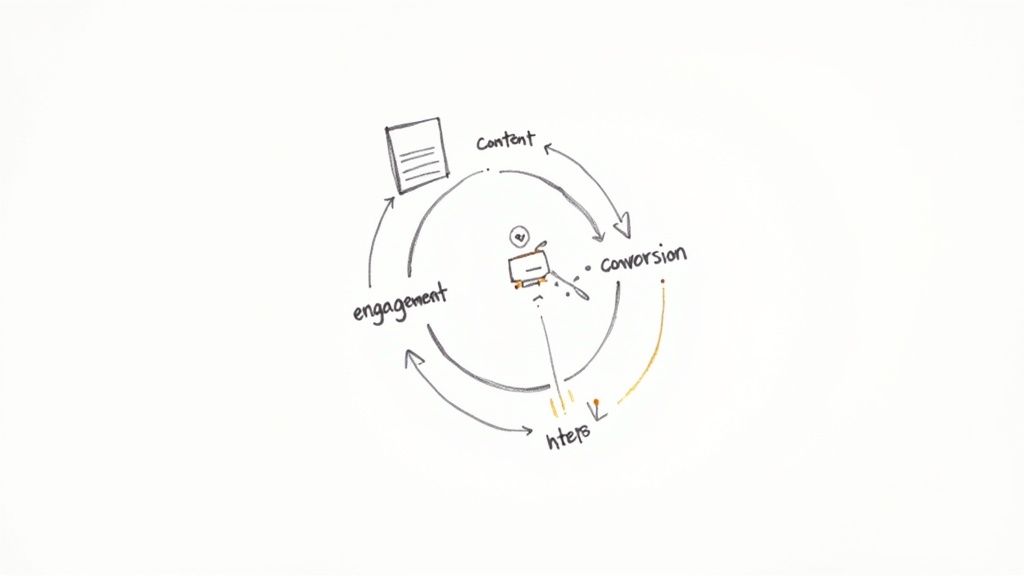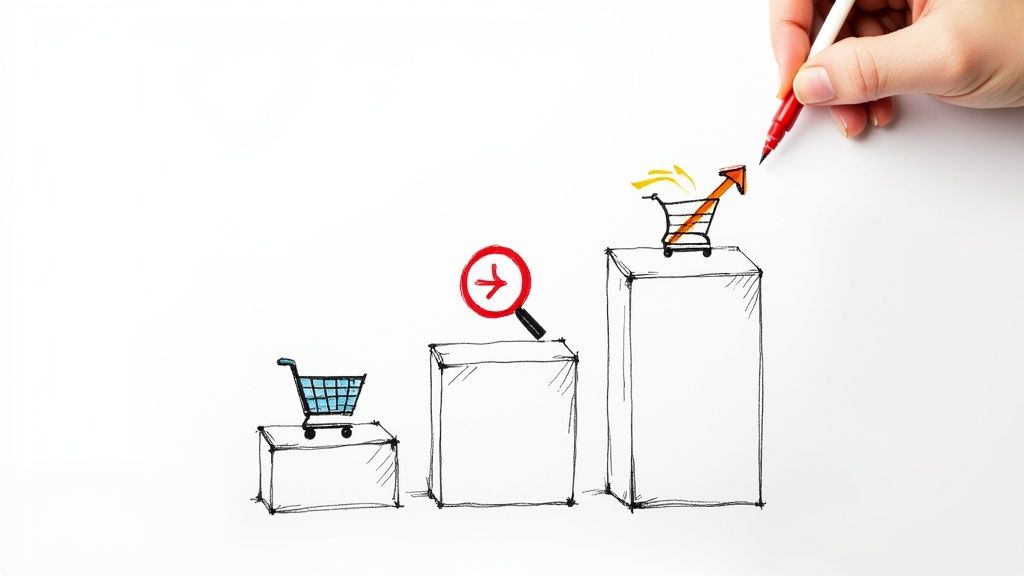Omnichannel Marketing Strategy: Build Customer Experiences

15 mins
6/10/2025
Joe Ervin
- omnichannel marketing strategy
- customer experience
- cross channel marketing
- retail marketing
- digital marketing
Understanding Omnichannel Marketing: Beyond the Buzzword
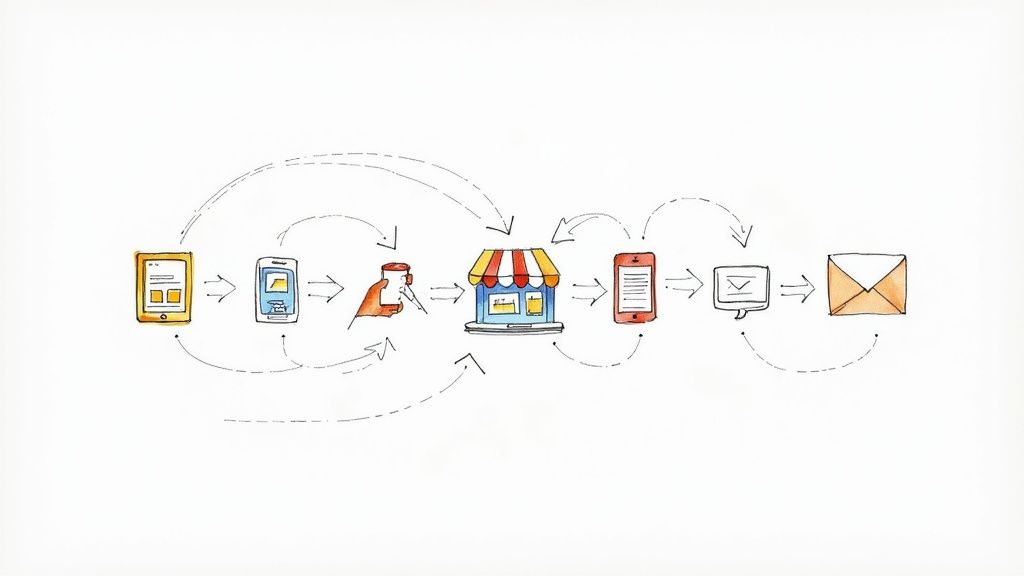 This screenshot from Salesforce illustrates how different customer touchpoints, from social media to email and in-store interactions, can be integrated into a cohesive omnichannel strategy. The image emphasizes the importance of a central hub for customer data, allowing businesses to deliver personalized and consistent messages across every channel. This helps meet customers where they are and guide them smoothly through their buying journey.
This screenshot from Salesforce illustrates how different customer touchpoints, from social media to email and in-store interactions, can be integrated into a cohesive omnichannel strategy. The image emphasizes the importance of a central hub for customer data, allowing businesses to deliver personalized and consistent messages across every channel. This helps meet customers where they are and guide them smoothly through their buying journey.
Many businesses think they're running omnichannel marketing simply because they're on multiple platforms. They might send emails, maintain a social media presence, and even run ads. But often, these channels operate independently. Think of it like different musicians playing different songs in the same room – noisy, chaotic, and ultimately ineffective. A true omnichannel marketing strategy creates a unified, seamless experience for the customer, regardless of how they interact with your brand.
For example, imagine a customer browsing your online store, adding a product to their cart, but then leaving without completing the purchase. A well-executed omnichannel strategy might trigger a personalized email reminding them about the item and offering a small discount. If they still don't buy, they might then see a retargeted ad on social media highlighting the product's benefits. This coordinated approach nurtures the customer and increases the chance of a sale.
This integrated approach isn't just a passing fad; it's a direct response to how consumer behavior has changed. Customers expect businesses to recognize them and provide consistent experiences across all touchpoints. They want to start a conversation on one channel and continue it seamlessly on another. The market is also recognizing the power of this approach. The global market for omnichannel retailing is booming and is expected to hit $25.35 billion by 2032. That's almost triple its $10.13 billion value in 2025, representing a strong annual growth rate of 14%. Discover more insights. This growth underscores the increasing importance of omnichannel strategies.
Successfully implementing an omnichannel marketing strategy requires a fundamental shift in thinking. It means moving away from a channel-centric focus and adopting a customer-centric one. This involves understanding the customer journey and tailoring every interaction to create a cohesive and personalized experience. It's about building relationships, not just making sales. The next section will delve into why this approach delivers tangible results.
The Numbers Tell The Story: Why Omnichannel Actually Works
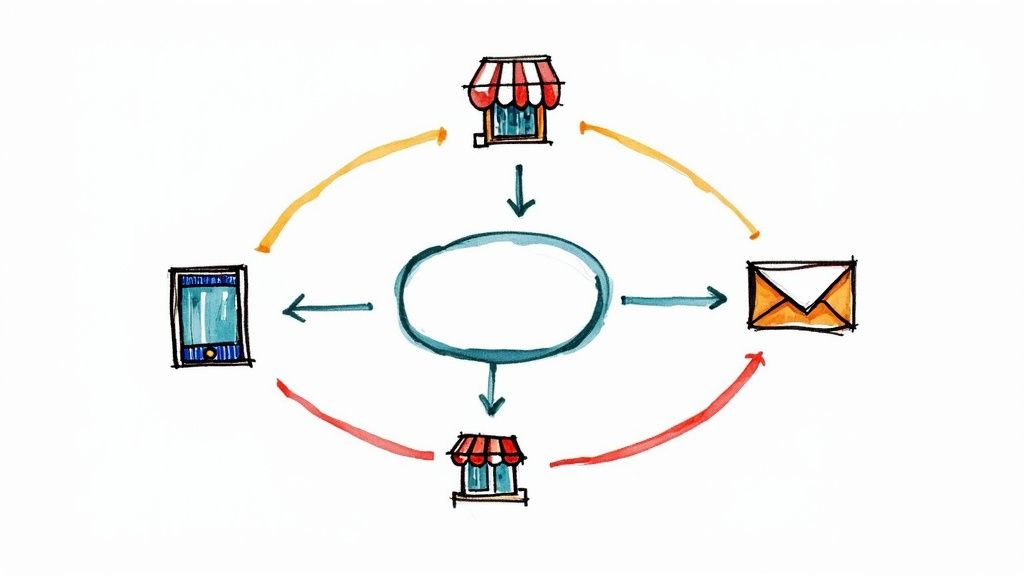
Think of switching from single-channel marketing to a true omnichannel strategy like trading a bumpy dirt road for a smooth, efficient superhighway. It's not just about being everywhere—it's about creating a connected, consistent experience that genuinely helps your business grow.
The Impact on Key Metrics
One of the strongest arguments for omnichannel marketing is its effect on conversion rates. When a customer feels understood and valued through a seamless, personalized experience, they're much more likely to buy. It builds trust, just like a good conversation builds rapport.
Also, customer lifetime value (CLTV) gets a major boost. Nurturing customers across different touchpoints—from email to social media—deepens relationships and encourages repeat purchases. This translates to higher average order values and longer-lasting customers, which ultimately means more profit for your business.
Customer retention rates see a dramatic improvement, too. A consistently positive experience keeps customers coming back. They're less likely to switch to a competitor, strengthening your customer base and creating a community of loyal brand advocates. It's a positive feedback loop that keeps the growth engine running.
The proof is in the pudding: omnichannel campaigns have a 287% higher purchase rate than single-channel efforts, according to 2025 data. That's not a small bump – it’s a testament to the power of connecting with customers on their terms, wherever they are. Learn more about these omnichannel statistics.
Let's look at a comparison to really illustrate this:
To illustrate the impact, let's take a look at a direct comparison:
| Metric | Single-Channel | Omnichannel | Performance Increase |
|---|---|---|---|
| Conversion Rate | 3% | 8% | 167% |
| Customer Retention Rate | 20% | 65% | 225% |
| Purchase Rate | 10% | 38% | 280% |
This table represents illustrative data based on industry averages and reported improvements from omnichannel adoption. Specific results may vary.
The table above paints a clear picture: omnichannel strategies significantly outperform single-channel approaches across the board. This boost in performance translates directly to improved bottom-line results for businesses.
Realistic Expectations and ROI
While the benefits are compelling, it's important to be realistic. Omnichannel done right takes investment—in the right technology (like Klaviyo for email marketing) and in training your team. Think of it as building a house, not just putting up a tent. It’s a long-term commitment, not a quick fix, but the payoff is worth it.
Speaking of payoff, the return on investment (ROI) can be significant. Businesses that successfully implement omnichannel marketing often see a big jump in revenue and profitability because they’re reaching more customers, converting them more effectively, and keeping them around for longer.
Avoiding Common Pitfalls
One common trap is treating each channel like a separate island. Imagine running a social media campaign that doesn't connect to your email marketing or website. It creates a fragmented, confusing experience for your customers.
Another mistake is forgetting to personalize. Customers today expect brands to know them and tailor their interactions accordingly. Generic messages and irrelevant offers can send potential customers running. Personalization is the key to making a genuine connection.
Inside Your Customer's Mind: The Psychology Behind Seamless Experiences

Customers aren't thinking about marketing channels. They're thinking about what they want and need. They're trying to solve a problem or achieve a goal. A good omnichannel marketing strategy recognizes this by creating experiences that feel natural and effortless.
The Power of Predictability
Our brains love patterns. We like to know what to expect. Think about your own online shopping habits. You probably favor brands that offer consistent and reliable experiences. This isn't about being picky. It's just human nature to prefer familiarity and ease. This is where a well-executed omnichannel strategy really comes into play.
For example, imagine you find a cool product on a brand's Instagram page. You click through to their website, fully expecting to find the same product readily available, with the same pricing and product details. This predictability builds trust and creates a positive brand impression. You might be interested in: ecommerce customer journey.
Friction Points and Lasting Impressions
On the other hand, inconsistent experiences create friction. Imagine adding something to your cart on your phone, only to find it gone when you switch to your computer. These little annoyances can have a surprisingly big impact on how a customer perceives your brand. They erode trust and can lead to abandoned purchases.
This means that in an omnichannel world, every touchpoint matters. A bad experience on one channel can damage the entire customer journey, even if the other touchpoints are excellent. In 2025, consumers were 90% more likely to buy from retailers who engaged them across multiple platforms. Find more insights here. This clearly shows the importance of a consistent brand presence across all channels.
Seamless vs. Disjointed: A Tale of Two Journeys
Let's compare two scenarios. In one, a customer moves seamlessly between email, website, and social media, encountering consistent messaging and personalized offers. In the other, the experiences are fragmented, the information inconsistent, and everything feels disjointed. The first builds trust and loyalty. The second leads to frustration and customers leaving.
Mapping the Emotional Journey
A truly effective omnichannel marketing strategy understands that the customer journey isn't just a series of steps. It's an emotional experience. By understanding the customer's emotional landscape alongside the functional steps in their journey, businesses can find key opportunities to turn casual shoppers into loyal brand advocates. This is the real strength of omnichannel.
Building Your Foundation: The Essential Components That Actually Work

This screenshot from HubSpot shows how different channels work together in an omnichannel marketing strategy. Think of it as a map of customer interactions, showing how they move between email, live chat, social media, and your website. The goal? A seamless and integrated experience. The image illustrates how this connected approach can nurture leads and guide them through your sales funnel.
Building a successful omnichannel strategy is a lot like building a house: you need the right foundation. This means investing in tools and processes that truly connect with your customers, not just chasing the latest marketing fads.
Assessing Your Current Capabilities
Before you rush out to buy new tools, take a look at what you already have. Just like checking your blueprints before starting construction, you need to audit your existing marketing technology and team structure. Where are the gaps between your current setup and a truly integrated omnichannel marketing strategy?
Prioritizing Investments for Maximum Impact
Once you know what you need, prioritize investments based on their impact, not just their novelty. Do you need a powerful customer data platform (CDP) to bring all your customer information together? Is your marketing automation working effectively? What about your content management system (CMS) and analytics integration? Focus on solutions that solve your specific problems and help you reach your business goals.
Building Unified Customer Profiles
Imagine hosting a dinner party. Wouldn't it be helpful to have a little background information on each guest, so you can tailor the conversation to their interests? That's the power of unified customer profiles. These profiles combine data from all your channels, giving you a 360-degree view of each customer.
Consistent Messaging Across Channels
Consistency is key in omnichannel marketing. But this doesn't mean blasting the same message everywhere. Instead, it's about adapting your core message to each platform's unique style. Think of it like speaking the same language but adjusting your tone and vocabulary depending on who you're talking to. For a deeper dive into this, check out our article on marketing automation for ecommerce.
Designing Workflows That Actually Work
Efficient workflows are crucial. They're like the gears in a well-oiled machine, ensuring every part works together smoothly. This involves defining roles, setting communication protocols, and streamlining processes to avoid bottlenecks. Most importantly, your workflows should be realistic and sustainable for your team.
Building In-House vs. External Expertise
Finally, be realistic about what you can handle in-house versus what needs outside help. Sometimes, partnering with experts is more efficient and cost-effective, especially for complex integrations or specialized marketing areas. Think of it like hiring a contractor for specific parts of your house build—sometimes, it's best to leave it to the pros.
To help you get started, take a look at the table below, which outlines the key technology components you'll need for a successful omnichannel strategy. It also provides a general overview of their function, priority level, and integration complexity. Use this as a guide when planning your omnichannel technology stack.
Essential Omnichannel Technology Stack Components
| Component | Function | Priority Level | Integration Complexity |
|---|---|---|---|
| Customer Data Platform (CDP) | Unifies customer data from multiple sources | High | Moderate to High |
| Marketing Automation Platform | Automates marketing tasks and workflows | High | Moderate |
| Content Management System (CMS) | Manages and delivers digital content | High | Moderate |
| Analytics Platform | Tracks and analyzes marketing performance | High | Moderate |
| Email Marketing Platform | Sends targeted email campaigns | High | Low to Moderate |
| Social Media Management Platform | Manages social media presence and engagement | Medium | Low to Moderate |
| Customer Relationship Management (CRM) | Manages customer interactions and relationships | Medium | Moderate |
This table provides a starting point for building your omnichannel tech stack. Remember to prioritize based on your specific needs and resources. While a CDP and marketing automation platform are generally considered high-priority, the specific requirements for your business may vary.
Making It All Connect: Channel Integration That Feels Natural
This is where the magic happens—transforming the idea of omnichannel marketing from a concept into a dynamic system. It's like having all the ingredients for a delicious meal and knowing exactly how to combine them to create a culinary masterpiece.
Weaving a Seamless Customer Journey: Email, Social, and Paid
Imagine your customer's journey as an ongoing conversation. You wouldn't abruptly switch topics or repeat yourself endlessly in a face-to-face chat. The same goes for online interactions. Your email marketing, social media presence, and paid advertising should collaborate to create a smooth, engaging experience.
Let's say someone joins your email list after downloading a helpful guide. Your welcome emails could share your brand's story and suggest related products. At the same time, you could use paid retargeting ads on Facebook or Instagram to reinforce those messages and showcase positive customer reviews. It's a coordinated effort, not a series of random messages.
Website Experiences: The Heart of Your Omnichannel Strategy
Your website isn't just a digital storefront; it's the central hub of your omnichannel world. It's where customers explore your products, learn about your brand, and make purchases. All other channels should ultimately guide customers back to this core location.
Think about personalizing website content based on past customer interactions. If someone showed interest in a particular product category through email, feature those items on their next website visit. This personalized touch makes customers feel valued and understood, strengthening their connection with your brand.
Bridging the Gap: Connecting Online and Offline
The line between online and offline experiences is blurring. Imagine using QR codes on printed materials to direct customers to specific landing pages or offering special discounts to in-store shoppers who join your email list. These offline touchpoints integrate seamlessly with your online presence, creating a truly cohesive brand experience.
The Art of Automation: Personalization, Not Robotics
Automation is a powerful tool, but it’s easy to misuse. No one wants to receive impersonal, robotic messages. The key is to use automation to enhance personalization, not to replace it.
Think about using data from your CRM (Customer Relationship Management software) to trigger automated emails based on customer actions. If someone abandons their online shopping cart, you could send a personalized email reminding them about the items they left behind and offering free shipping. This feels helpful and relevant, not pushy.
Timing is Everything: Maximizing Impact Without Overwhelm
Just like a well-timed joke, the timing of your messages is crucial. Flooding customers with notifications across multiple channels can be overwhelming and lead to unsubscribes. Think strategically about when and how you communicate.
Consider a staggered approach. Instead of sending an email, a social media ad, and a text message all at once, spread them out over a few days. This gives your message time to resonate without overwhelming your audience.
Adapting Content Across Channels: Maintaining a Consistent Brand Voice
Every channel has its own distinct style. A tweet is different from an email, and a Facebook post differs from an Instagram story. While your core message should stay consistent, adjust the format and tone to match each platform.
Think of it like dressing for different occasions. You might wear a suit to a formal event and jeans to a casual gathering, but your personal style still shines through. Similarly, your brand voice should be recognizable across all channels, even as you tailor your content to each platform.
Overcoming Real-World Integration Challenges
Omnichannel marketing has its challenges. Technical issues, data silos, and team coordination problems can create obstacles. But with a clear plan and a focus on practical solutions, these hurdles can be overcome.
Facing these challenges head-on is essential for long-term success. By promoting open communication, investing in the right tools, and finding workable solutions, you can create a truly integrated omnichannel strategy that delivers exceptional results.
Measuring Success: Tracking What Actually Drives Growth
Think of your omnichannel marketing strategy like a symphony orchestra. You wouldn't judge the entire performance based solely on the violins, right? You need to hear how all the instruments work together to create the full, beautiful sound. Similarly, focusing only on isolated metrics like email open rates or social media likes won't give you the complete picture of your marketing effectiveness. You need to see the whole orchestra.
Key Performance Indicators for Omnichannel Success
So, if those individual metrics aren't enough, what should you be measuring? The key is to focus on indicators that reflect the entire customer journey, from the first note to the final crescendo.
Customer Journey Analytics: This is like watching the entire orchestra perform, seeing how each section (email, social media, etc.) contributes to the overall harmony. Tools like Google Analytics can help you visualize this journey and identify areas for improvement. You might discover, for example, that customers who interact with both email and social media are more likely to make a purchase.
Attribution Models: These models help determine how much credit each touchpoint (each instrument in the orchestra) deserves for a conversion (a standing ovation). A multi-touch attribution model, for example, recognizes that an earlier email or social media interaction might have played a crucial role in influencing the final purchase decision, rather than giving all the credit to the last click.
Customer Lifetime Value (CLTV): A good omnichannel strategy should increase the value of your customers over time. Tracking CLTV shows you the long-term impact of your efforts—the lasting impression your symphony leaves on the audience.
Customer Retention Rate: This measures how many customers return for repeat purchases. A higher retention rate often indicates a stronger, more loyal customer base—fans who come back for every performance.
Customer Satisfaction (CSAT) and Net Promoter Score (NPS): These metrics capture the quality of the customer experience. Happy customers are more likely to become repeat buyers and advocates for your brand—spreading the word about your incredible symphony.
Setting Up Effective Measurement Frameworks
This screenshot from a Google Analytics dashboard shows how you can visualize metrics like website traffic sources and conversions. This data helps pinpoint which channels bring in the most valuable traffic. By analyzing this information, you can fine-tune your strategy for better results.
You might also find this helpful: Improving your ecommerce customer retention. A robust measurement framework goes beyond simply tracking numbers. It helps you understand why things are happening. This requires a combined approach, using both data and qualitative insights, like analyzing customer feedback alongside conversion data.
Optimizing and Scaling Your Omnichannel Strategy
Measurement isn't about collecting data for data's sake; it's about improvement. A good framework helps you identify areas to optimize, systematically test changes, and then scale those winning strategies across your entire operation. Think of it like fine-tuning each instrument and then conducting the whole orchestra to play even better.
For example, imagine you discover that your welcome email series has a high drop-off rate after the second email. You could test different subject lines or content to see what improves engagement. If one change makes a big difference, you can implement it across the whole series.
Measuring omnichannel success requires a shift in perspective. Move beyond single-channel metrics and embrace a holistic view of the customer journey. By focusing on key indicators like CLTV, retention rate, and customer satisfaction, you gain a true understanding of what drives growth and can optimize for long-term success. You become the conductor of your own marketing symphony.
Learning From the Leaders: Real Success Stories and Actionable Insights
Real-world examples offer invaluable lessons. Let's explore how businesses, from established retailers to nimble startups, have leveraged omnichannel marketing strategies to achieve remarkable results.
Fashion Retailer Boosts Customer Lifetime Value
Imagine a mid-sized fashion retailer aiming to cultivate deeper customer relationships and boost sales. Their solution? An integrated omnichannel experience seamlessly connecting their online and offline touchpoints. They introduced a loyalty program rewarding customers for both online and in-store purchases. Sales associates gained access to customer purchase history and preferences, enabling them to offer personalized recommendations and styling advice. Meanwhile, online shoppers received targeted emails showcasing new arrivals based on their past purchases.
The result? A striking 40% increase in customer lifetime value. This vividly demonstrates how a connected experience strengthens customer loyalty and fosters repeat business.
B2B Software Company Streamlines Acquisition
Consider a B2B software company grappling with high acquisition costs. They realized their marketing messages were fragmented across various channels, creating confusion for potential customers. To address this, they overhauled their omnichannel marketing strategy, crafting consistent content that resonated across their website, blog, social media, and email campaigns. They also implemented a lead nurturing system, providing valuable information to prospects at each stage of the buying process.
This coordinated approach yielded a significant 25% reduction in acquisition costs and a noteworthy 15% improvement in conversion rates. This underscores how a unified message across channels simplifies the buying journey and optimizes marketing spend.
Local Businesses Compete With National Brands
Local businesses often encounter intense competition from larger national brands. However, a clever omnichannel approach can help level the playing field. Picture a local bookstore hosting in-store events, offering personalized recommendations via email, and actively engaging with customers on social media platforms like Facebook and Instagram. This multi-faceted strategy cultivates a strong sense of community, attracting customers who appreciate personalized service and local connections. This creates a unique advantage that large, impersonal chains struggle to replicate.
Key Takeaways and Actionable Insights
These examples offer valuable lessons:
Focus on the Customer Journey: Craft experiences that seamlessly transition across all touchpoints, from your website and email to social media.
Prioritize Personalization: Leverage data to understand customer preferences and tailor every interaction accordingly.
Integrate Online and Offline: Bridge the divide between your physical and digital presence for a truly unified experience.
Measure What Matters: Track key performance indicators (KPIs) like customer lifetime value and retention rate to gauge the effectiveness of your strategy.
By learning from these successful businesses, you can develop your own thriving omnichannel marketing strategy, fueling growth and nurturing enduring customer relationships. This requires effort and dedication, but the rewards are well worth it. Remember, omnichannel marketing isn't a one-size-fits-all solution. It's about discovering the optimal approach for your specific business and customers.
